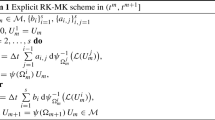Summary
A simple systematic method has been developed to investigate the laws of conservation for approximating model equations. The main purpose of this paper is to identify these model equations as approximations of continuous Hamiltonian systems. If this identification is possible, the laws of conservation of the model system can be investigated as for a finite dimensional Hamiltonian system. Obviously, this method can be applied only in the case where the original continuous equations are Hamiltonian. The applicability of the general method has been verified by using three well-known finite-difference schemes as examples. These examples show that this technique is a possible systematic way to construct new conservative finite-difference approximations, as well as to identify the conserved quantities of well-known schemes.
Similar content being viewed by others
References
Arakawa, A., 1966: Computational design for long-term numerical integration of equations of fluid motion: Two-dimensional incompressible flow. Part I.J. Comput. Phys.,1, 119–143.
Arakawa, A., Lamb, V. R., 1981: A potential enstrophy and energy conserving scheme for the shallow water equations.Mon. Wea. Rev.,109, 18–36.
Arnold, V. I., 1989:Mathematical Methods of Classical Mechanics, 2nd ed. New York: Springer.
Benjamin, T. B., 1984: Impulse, flow force and variational principles.IMA J. Appl. Math.,32, 3–68.
Goldstein, H., 1980:Classical Mechanics, 2nd ed. Reading, Massachusetts: Addison-Wesley.
Marsden, J. E., O'Reilly, O. M., Wicklin, F. J., Zombros, B. W., 1991: Symmetry, stability, geometric phases, and mechanical integrators (Part I).Nonlinear Science Today,1, 4–11.
Ripa, P., 1981: Symmetries and conservation laws for inertial gravity waves. In: West, B. J. (ed.),Nonlinear Properties of Internal Waves. AIP Conf. Proc.,76, 281–306. Am. Inst. Phys., New York.
Sadourny, R., 1975: The dynamics of finite-difference models of the shallow-water equations.J. Atoms. Sci.,32, 680–689.
Salmon, R., 1988: Semigeostrophic theory as a Dirac-bracket projection.J. Fluid Mech.,196, 345–358.
Scinocca, J. F., Shepherd, T. G., 1992: Nonlinear wave-activity conservation laws and Hamiltonian structure for the two-dimensional anelastic equations.J. Atoms. Sci.,49, 5–27.
Shepherd, T. G., 1990: Symmetries, conservation laws, and Hamiltonian structure in geophysical fluid dynamics.Adv. Geophys.,32, 287–338.
Vallis, G. K., 1992: Problems and phenomenology in two-dimensional turbulence. In: Carnevale, G. F., Pierrehumbert, R. T. (eds.)Nonlinear Phenomena in Atmospheric and Oceanic Sciences. New York: Springer.
Author information
Authors and Affiliations
Rights and permissions
About this article
Cite this article
Szynyogh, I. Finite-dimensional quasi-Hamiltonian structure in simple model equations. Meteorl. Atmos. Phys. 52, 49–57 (1993). https://doi.org/10.1007/BF01025752
Received:
Revised:
Issue Date:
DOI: https://doi.org/10.1007/BF01025752




